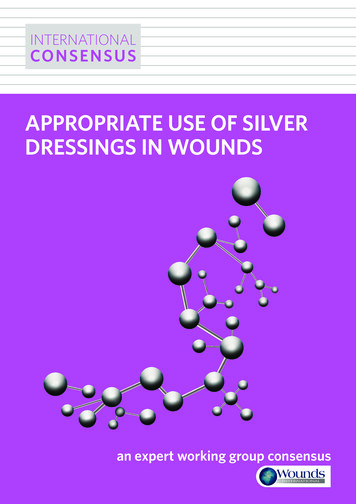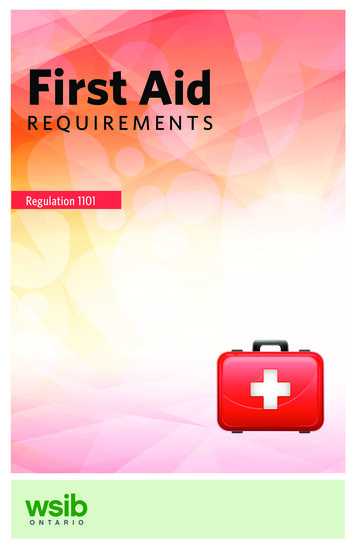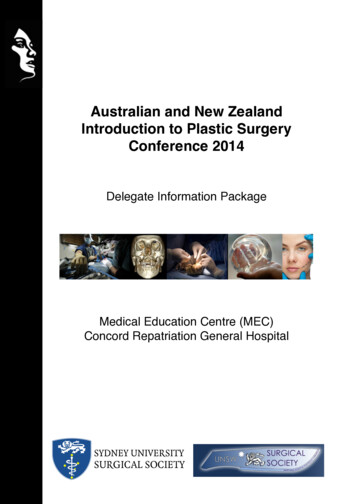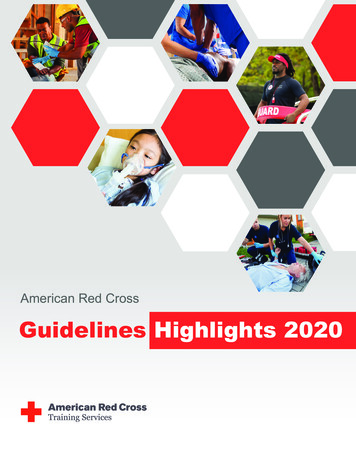
Transcription
INTERNATIONALCONS E N S U SAPPROPRIATE USE OF SILVERDRESSINGS IN WOUNDSan expert working group consensus
EDITOR:Lisa MacGregorPUBLISHER:Kathy DayPUBLISHED BY:Wounds InternationalEnterprise House1–2 HatfieldsLondon SE1 9PG, UKTel: 44 (0)20 7627 1510Fax: 44 (0)20 7627 ional.com Wounds International 2012This document has beendeveloped by WoundsInternational and supportedby an unrestricted educationalgrant from B Braun, ConvaTecand Systagenix.The views expressed are thoseof the expert working groupand review panel and donot necessarily reflect thoseof B Braun, ConvaTec andSystagenix.How to cite this document:International consensus.Appropriate use of silver dressingsin wounds. An expert workinggroup consensus. London:Wounds International, 2012.Available to download from:www.woundsinternational.comFOREWORDTopical antimicrobial dressings, including those that contain silver, are used to prevent ormanage infection in a wide range of wounds. Although silver dressings have been usedextensively, a recent study1 and two Cochrane reviews2,3 have concluded that there isinsufficient evidence to show that silver dressings improve healing rates. The overall effecthas been to cast doubt into the minds of healthcare purchasers and to cause restrictions inthe availability of silver dressings worldwide. There is growing concern amongst cliniciansthat arbitrary withdrawal of silver dressings could lead to increased morbidity andprolonged treatment time relating to uncontrolled wound bioburden.A group of experts from Europe, North America, the Far East, South Africa and Australiamet in December 2011 to provide internationally-recognised guidance for the proper useof silver dressings, based on experience in clinical practice and all the available evidence.This document presents the mechanisms by which silver dressings work, the relationshipof in vitro and in vivo evidence to clinical practice and provides a rationale for cost-effectivemanagement.Following the consensus meeting, a draft document was produced, which underwentextensive review by the expert working group. Additional international experts werealso consulted to reflect practice across different parts of the world. This culminatedin a consensus by all members of the extended expert working group on all statementspresented in the document.Professor David Leaper EXPERT WORKING GROUPElizabeth A Ayello, Excelsior College School of Nursing, Albany, New York (USA)Keryln Carville, Silver Chain Nursing Association & Curtin University, Osborne Park, Perth(Western Australia)Jacqui Fletcher, Section of Wound Healing, Cardiff University (UK)David Keast, Aging Rehabilitation and Geriatric Care Research Centre, St Joseph's ParkwoodHospital, London, Ontario (Canada) (Co-Chair)David Leaper, Wound Healing Research Unit, Cardiff University (UK) (Chair)Christina Lindholm, Sophiahemmet University College, Karolinska University Hospital, Stockholm(Sweden)José Luis Lázaro Martínez, Diabetic Foot Unit, Complutense University, Madrid (Spain)Silindile Mavanini, Inkosi Albert Luthuli Central Hospital, Durban (South Africa)Andrew McBain, School of Pharmacy and Pharmaceutical Sciences, University of Manchester(UK)Zena Moore, Faculty of Nursing & Midwifery, Royal College of Surgeons in Ireland, Dublin (Ireland)Supaporn Opasanon, Division of Trauma Surgery and Burn Unit, Department of Surgery, SirirajHospital, Mahidol University (Thailand)Elaine Pina, National Programme for Infection Control, Directorate General of Health, Lisbon(Portugal)REVIEW PANELValerie Edwards-Jones, School of Research, Enterprise and Innovations, Faculty of Science andEngineering, Manchester Metropolitan University, Manchester (UK)Jenny Hurlow, Plastic Surgery Group of Memphis, Tennessee (USA)
Silver dressings — current issuesCOMMON TERMSEXPLAINEDBacteriostatic: preventsbacteria from growing orreproducingBactericidal: kills bacteriaOligodynamic: active oreffective in very smallquantitiesIn vivo: experimentationon a whole living animalIn vitro: experimentationon components of ananimal or organismAntimicrobial tolerance:bacteria in a biofilm maytake on a dormant statein which their slowermetabolism makes themless susceptible to theeffects of antimicrobialsAntibiotic resistance:the ability of bacteria toavoid harmful effectsof antibiotic agents byundergoing geneticchangesTHE HISTORY OF SILVERThe topical antimicrobial agent silver has been used for hundreds of years in wound care4.For example, silver has been used to prevent or manage infection in its solid elementalform (eg silver wire placed in wounds), as solutions of silver salts used to cleanse wounds(eg silver nitrate solution), and more recently as creams or ointments containing a silver–antibiotic compound (silver sulfadiazine (SSD) cream).Silver nitrate solution is less widely used nowadays, but SSD cream has been an importantpart of burns management for many years5. SSD cream, however, is relatively short-acting,requires reapplication at least daily, and is time-consuming and messy to apply and remove.In recent years, a wide range of wound dressings that contain elemental silver or a silverreleasing compound have been developed (see Appendix 1, page 20). These dressingshave overcome some of the problems associated with the first silver preparations. They areeasier to apply, may provide sustained availability of silver, may need less frequent dressingchanges, and may provide additional benefits such as management of excessive exudate,maintenance of a moist wound environment, or facilitation of autolytic debridement6.The use of silver dressings in wound care has recently been faced with considerablechallenges. These include a perceived lack of efficacy and cost effectiveness, andquestions about safety1–3,7,8. In some healthcare settings, these challenges have led torestrictions in the availability or complete withdrawal of silver dressings9,10. This has leftsome clinicians in the frustrating position of not being able to use silver dressings forpatients who may find them beneficial.In the context of increasing resistance to antibiotics and the dramatic fall in the number ofantibiotics in development, restriction of other potentially useful antimicrobial treatmentssuch as silver dressings is particularly unfortunate11,12. Topical antiseptics, such as silver,differ from antibiotics: they have multiple sites of antimicrobial action on target cells andtherefore a low risk of bacterial resistance13. As a result, antiseptics have the potential to playan important part in controlling bioburden in wounds while limiting exposure to antibioticsand reducing the risk of development of further antibiotic resistance. See Box 1 below formore information on antimicrobial agents.BOX 1: Antimicrobial agents (modified from14–16)Antimicrobial – any agent that kills or prevents the multiplication of microorganisms, eg bacteria or fungi.Antimicrobials may be antibiotics, antiseptics or disinfectantsAntibiotics – agents that act selectively against bacteria and may be administered systemically or sometimestopically (although topical antibiotics are not recommended for wounds). They usually have one specifictarget of disruptive activity in bacterial cells and act against a narrower range of bacteria than antiseptics.Development of resistance to antibiotics is an increasing problemAntiseptics – chemical agents that can be applied topically to skin or wounds. They are relatively nonselective agents that inhibit multiplication of, or kill, microorganisms. They may also have toxic effects ontissue cells, which has led to controversy and reduced their widespread use. Development of resistance toantiseptics is unknown in wound care. Antiseptics are often referred to as 'topical antimicrobials' even thoughthe term also applies to topical antibioticsDisinfectants – relatively non-selective agents often with multiple sites of action that kill a wide range ofmicroorganisms including bacteria and fungi. Disinfectants are generally not suitable for use on body tissuesbecause they are toxic to human cellsAPPROPRIATE USE OF SILVER DRESSINGS IN WOUNDS 1
Challenging common misperceptionsabout silverMisperception 1: 'Silver dressings don't improve healing rates'The proportion of wounds that heal completely is a common endpoint in clinical studiesof wound care and is insisted upon by regulatory bodies such as the Food and DrugAdministration (FDA) of the USA. Given that chronic wounds are difficult to heal, theappropriateness of such an endpoint has been questioned17–20. The aim of treatment with silverdressings is to reduce wound bioburden, treat local infection and prevent systemic spread:their main purpose is not to promote wound healing directly. Clinical guidelines recommendthat silver dressings are used for wounds where infection is already established or an excessivewound bioburden is delaying healing ('critical colonisation' or 'pre-infection'), and that they areused for short periods before re-evaluation16. Two influential Cochrane reviews and a high profile randomised controlled trial (RCT)of silver dressings have concluded that silver dressings do not improve healing rates1–3.However, the use of silver dressings in the reviews and in the RCT was not always asindicated by the manufacturers: in some cases they were used for extended periods andsometimes on wounds that were not infected or did not show evidence of heavy bioburden.The overall effect has been to cast doubt in the minds of healthcare purchasers on theefficacy of silver.The experience of many clinicians, and more recent systematic reviews and meta-analyses,have confirmed positive effects of silver dressings when used appropriately21–23Misperception 2: 'Silver dressings cause systemic toxic effects such as argyria'Silver dressings occasionally cause local skin discolouration or staining which is harmless andusually reversible24,25. This discolouration is not true systemic argyria, which is rare and usuallyrelated to oral ingestion of silver solutions as an alternative health practice26, 27. True argyriais the result of deposition of silver compounds in the skin and internal organs and presentsas generalised blue-grey skin discolouration, particularly in light exposed areas24. Argyrosisoccurs when silver is deposited in the cornea or conjunctiva. True argyria and argyrosis areunsightly and irreversible, but not usually pathological or life threatening24,28. The total amountof silver required to cause argyria is unknown, but total body contents of 3.8–6.4g have beensuggested24.Silver dressings are unlikely to cause true argyria because only low levels of silver arepresented for systemic absorption28Misperception 3: 'Silver dressings are toxic to wounds and delay healing'Some in vitro studies have found that some silver-containing dressings are cytotoxic tokeratinocytes and fibroblasts, and delay epithelialisation in animal wound models24,29.Conversely, other studies have found some silver preparations not to be toxic and havesuggested that silver has actions that may promote healing24,29-31. Given the conflictingevidence, but wealth of positive clinical experience of silver, a pragmatic argument could bemade that silver dressings should be used appropriately, in common with recommendationsfor antimicrobial dressing use.Silver dressings should not be used on wounds where bioburden is not a problem, ie theyshould be reserved for use in wounds with or at risk of high bioburden or local infection2 INTERNATIONAL CONSENSUS
Misperception 4: 'Bacteria become resistant to silver'The prevalence of resistance to silver is unknown, but resistance appears to be rare and muchless common than might be expected given the considerable time that silver preparations havebeen in use and the widespread distribution of low levels of silver in the environment25,32–35. Silverhas multiple actions against microbial cells. This reduces the chance that resistance to silver willdevelop. In contrast, antibiotics generally have a single target site and hence bacterial cells maymore easily develop resistance36. Clinically, there may be alternative explanations for apparentsilver resistance. For example, infected wounds that appear not to respond to an antimicrobialdressing may have a deeper unrecognised infection, may contain biofilm that facilitatesantimicrobial tolerance, or may have an inadequately managed underlying comorbidity37.An apparent lack of response to silver does not relate to resistance, rather to inappropriate treatmentof the underlying infection and/or wound aetiologyMisperception 5: 'Silver dressings could make bacteria resistant to antibiotics'There has been concern that the use of silver dressings may lead to the emergence of bacteriathat are resistant to antibiotics8,13,38,39. Although this is theoretically possible, there is no directevidence that cross-resistance between silver and antibiotics has occurred13,40.The major cause of antibiotic resistance remains misuse or overuse of antibiotics themselvesMisperception 6: 'Silver dressings shouldn't be used in children'Reports of increased blood silver levels in children with burns and epidermolysis bullosa havecaused concern and withdrawal of silver dressings in some places41–44. However, it is possiblethat some paediatric wounds may benefit from use of silver.Silver dressings should be used in the treatment of children with caution and the dressingsshould not be used for more than two weeks without good clinical reasons45Misperception 7: 'Silver dressings are bad for the environment'Concerns have been raised that silver released into the environment may be harmful8. Certainly,silver is used worldwide in a wide range of technologies and the environmental impact of silver isnot clear28. A main silver dressing producer has estimated that it uses 0.0008% of global annualsilver consumption46.The proportion of total silver production that is used in dressings is very smallMisperception 8: 'Silver dressings are too expensive'The assessment of the cost effectiveness of wound treatments is not straightforward. Thetotal cost of wound care involves many direct and indirect costs, and some costs are difficultto measure, eg reduced productivity at work or in the home, reduced quality of life, and socialisolation47. Several silver dressing studies have demonstrated beneficial effects on overall cost ofwound management and on quality of life parameters48–51.Silver dressings are generally no more expensive than other types of antimicrobialdressingsAPPROPRIATE USE OF SILVER DRESSINGS IN WOUNDS 3
Understanding silver dressings*Elemental silver in verysmall crystals that areabout 10–100 nanometres(nm) in diameter (ananometre is one billionthof a metre)28Silver is found in dressings in a number of forms: elemental silver – eg silver metal, nanocrystalline silver* an inorganic compound – eg silver oxide, silver phosphate, silver chloride, silver sulfate, silvercalcium-sodium phosphate, silver zirconium compound, SSD (Box 2) an organic complex – eg silver-zinc allantoinate, silver alginate, silvercarboxymethylcellulose30,37,52.BOX 2: SSD dressings and silver dressings – the differenceDressings that contain SSD are often classified with other silver-containing dressings even though theyare fundamentally different. The sulfadiazine element of SSD is an antibiotic and so SSD dressings containtwo antimicrobial agents. Distinguishing the antimicrobial effects of the two agents is difficult and makescomparison with dressings that contain silver alone problematic. Difficulties and confusion may arise whenstudy findings relating to the efficacy and safety of SSD are extended to silver dressings in generalThe silver component of dressings may appear: as a coating – on one or both external surfaces of the dressing (elemental or nanocrystallinesilver) within the structure of the dressing – either as a coating on dressing materials (elemental orcompound silver), within the spaces of the dressing materials (elemental or compound silver),or as a compound that forms part of the dressing structure (eg silver alginate) as a combination of these.Silver on the surface of the dressing may come into contact with the wound where it exertsthe antimicrobial action. Silver within the dressing structure acts on bacteria absorbed into thedressing with wound exudate, but is likely also to diffuse to some extent into the wound53. The total amount of silver in dressings varies considerably53, but in a wound environment theinteraction of silver ions with wound components such as chloride ions and proteins, means thatthe amount of silver delivered to a wound does not correlate with the amount of silver containedin the dressing37. In addition, although in some laboratory experiments very low concentrations,eg one part per million (1ppm) of silver ions or less, have been shown to be effective againstbacteria54, it is unclear how silver content and availability measured in experimental settingsrelate to clinical performance53.Although attempts have been made to quantify the availability of silver from silver dressings,such measurements are currently of very limited value in predicting clinical efficacy4 INTERNATIONAL CONSENSUS
Mode of action of silverHOW DOES SILVER WORK?In metallic (elemental) form, silver is unreactive and cannot kill bacteria. To become bactericidal,silver atoms (denoted as Ag or Ag0) must lose an electron and become positively charged silverions (Ag ). Elemental silver ionises in air, but ionises more readily when exposed to an aqueousenvironment such as wound exudate. In contrast, silver compounds contain positive silver ionsbound to negatively charged ions or molecules. When exposed to aqueous environments, some ofthe silver ions become detached from the compound.Silver ions are highly reactive and affect multiple sites within bacterial cells, ultimately causingbacterial cell death. They bind to bacterial cell membranes, causing disruption of the bacterialcell wall and cell leakage. Silver ions transported into the cell disrupt cell function by binding toproteins and interfering with energy production, enzyme function and cell replication54,55. Silverions are active against a broad range of bacteria, fungi and viruses13, including many antibioticresistant bacteria, such as meticillin-resistant Staphylococcus aureus (MRSA) and vancomycinresistant Enterococci (VRE)56.Studies of the effects of silver dressings on experimental models of biofilms (Box 3) havesuggested that silver may reduce bacterial adhesion and destabilise the biofilm matrix57, as wellas kill bacteria within the matrix and increase susceptibility of bacteria to antibiotics58–60.Other effects of silverSome laboratory studies have suggested that silver may have beneficial effects on wound healingother than the control of bioburden alone. For example, silver nitrate, nanocrystalline silver, andsome silver-containing dressings have been found to have anti-inflammatory effects and toencourage blood vessel formation (neovascularisation)24,28,52,61. The clinical relevance of thesefindings is not yet known.WHAT HAPPENS TO SILVER?Only a small proportion of silver presented to a wound site in a dressing is involved inantimicrobial action. Most of the rest remains within the dressing or binds to proteins in thewound or wound debris4,52. Very little is systemically absorbed28.Even if absorbed systemically, silver is excreted mainly via the biliary route in faeces. Some is alsoexcreted in urine24. Silver is not absorbed into the central or peripheral nervous systems24.BOX 3: What are biofilms and how should they be managed?Biofilms are complex microbial communities, containing bacteria and sometimes also fungi, which are embeddedin a protective polysaccharide matrix. The matrix attaches the biofilm to a surface, such as a wound bed, andprotects the microorganisms from the host's immune system and from antimicrobial agents such as antisepticsand antibiotics62. Biofilms are commonly present in chronic wounds, and are thought to contribute to, andperpetuate, a chronic inflammatory state that prevents healing63.Currently, the management of biofilms involves: reduction of biofilm burden through debridement and/or vigorous cleansing to remove the biofilmand the dormant (persister) bacteria prevention of biofilm reformation through the use of topical antimicrobials to kill planktonic (free-floating)bacteria62.Further research is required to further understand how biofilms form and to determine the best approach totreatment. In particular, the role of antimicrobial cleansing agents and the potential benefits of rotating thetopical antimicrobial agent used need to be investigatedAPPROPRIATE USE OF SILVER DRESSINGS IN WOUNDS 5
Recommendations for theappropriate use of silver dressingsNOTE: In this document,dressings containingantiseptic agentsare referred to as'antimicrobial dressings'(see Box 1, page 1)This section summarises the recommendations for the appropriate use of silver dressings agreed by theconsensus groupThe major roles for antimicrobial dressings such as silver dressings in the management of wounds are to: reduce bioburden in acute or chronic wounds that are infected or are being prevented from healingby microorganisms act as an antimicrobial barrier for acute or chronic wounds at high risk of infection or re-infection14.REDUCING BIOBURDENThe effects of bacteria in a wound are often described as a continuum which extends fromcontamination (the presence of bacteria without problems), to colonisation (the presence ofmultiplying bacteria), to infection with tissue invasion14 (Figure 1). Infection may be localised tothe wound, spread into nearby tissues, or cause systemic illness such as systemic inflammatoryresponse syndrome (SIRS) or multiple organ dysfunction syndrome (MODS).The classic signs of local infection are pain, heat, swelling, redness and loss of function, and maybe accompanied by purulent discharge, pyrexia and malodour. However, in chronic wounds,the patient often has comorbidities that suppress the signs of inflammation14,64. As a result,identifying infection in chronic wounds may be difficult and clinicians need to rely on other signsand symptoms (see Box 4, page 7). This problem prompted the term 'critical colonisation' tobe devised. The term is not universally accepted and some clinicians prefer 'covert infection' or'subclinical infection' to convey a similar concept64.In practice, most healthcare practitioners rely on clinical signs and symptoms to diagnosewound infection64,65. Even where microbiological services are readily available, it is notrecommended that microbiological tests are performed routinely14.Silver dressings may be used on acute wounds, such as traumatic wounds (including burns) orsurgical wounds, and chronic wounds that present with localised (overt or covert), spreading orsystemic infection (Figure 1). Manufacturer's instructions should be followed regarding woundcleansing and method of application of silver dressings (eg recommended cleansing materialsand whether hydration of the dressing is required).Inflamed wounds may be particularly suited to management with silver dressings because ofthe anti-inflammatory effects observed in experimental n Topical antimicrobial dressings arenot indicated because bioburden isnot causing clinical problemsLocalisedInfection* Colonisation Contamination Figure 1 When to implementantimicrobial dressings(adapted from14,15,64)Topical antimicrobialdressings indicatedSystemic antibiotics topical antimicrobial dressingsindicated*Including critical colonisation (also known as 'covert' or 'silent' infection or 'pre-infection'). Patients with chronic wounds often havecomorbidities that suppress the signs of inflammation and make identification of infection difficult.NB: Treatment for wound infection should take place in the context of standard care for the wound type, eg debridement, offloading andcorrection of underlying factors such as malnutrition, ischaemia and hyperglycaemia to enhance the patient's healing potential and abilityto fight infection.6 INTERNATIONAL CONSENSUS
Box 4: Signs and symptoms of localised, spreading and systemic infection in wounds. Reproduced withpermission from14Localised infectionSpreading infectionACUTE WOUNDS eg surgical or traumatic wounds, burns Classical signs and symptoms:– new or increasing pain– erythema– local warmth– swelling– purulent discharge Pyrexia Delayed or stalled healing Abscess MalodourAs for localised infection, plus: Further extension of erythemaLymphangitisCrepitus in soft tissuesWound breakdown/dehiscenceCHRONIC WOUNDS eg diabetic foot ulcers, venous leg ulcers, arterial leg/foot ulcers, pressure ulcers New, increased or altered painDelayed (or stalled) healingPeriwound oedemaBleeding or friable granulation tissueDistinctive malodour or change in odourWound bed discolourationIncreased, altered or purulent exudateIndurationPocketing or bridgingAs for localised chronic infection, plus: Wound breakdown Erythema extending from the wound edge Crepitus, warmth, induration or discolouration spreadinginto periwound area Lymphangitis Malaise or non-specific deterioration in the patient'sgeneral conditionSYSTEMIC INFECTIONSepsis: documented infection with pyrexia or hypothermia, tachycardia, tachypnoea, raised or depressed white blood cell countSevere sepsis: sepsis and multiple organ dysfunctionA diagnosis of localised, spreading or systemic infection should be documented in the patient'shealth records along with treatment objectives, baseline data and rationale for use of the silverdressing, together with the timeframe for reviewing management16. Silver dressings should be used in the context of accepted standard wound care whichinvolves a holistic assessment of the patient and the wound, management of underlyingcomorbidities, and wound bed preparation68Silver dressings should not be used in the absence of localised (overt or covert), spreading orsystemic infection, unless there are clear indicators that the wound is at high risk of infection orre-infection. Box 5 summarises the situations where silver dressings should not be used.BOX 5: When not to use silver dressings In the absence of signs of localised (overt or covert), spreading or systemic infection Clean surgical wounds at low risk of infection, eg donor sites, closed surgical woundsChronic wounds healing as expected according to comorbidities and ageSmall acute wounds at low risk of infectionPatients who are sensitive to silver or any of the dressing componentsWounds being treated with enzymatic debridementDuring pregnancy or lactationWhen contraindicated by the manufacturer, for example, some manufacturers recommend thattheir silver dressings are not used during magnetic resonance imaging (MRI), or on/near body sitesundergoing radiotherapyAPPROPRIATE USE OF SILVER DRESSINGS IN WOUNDS 7
THE TWO WEEK 'CHALLENGE'It has been recommended that antimicrobial dressings should be used for two weeks initiallyand then the wound, the patient and the management approach should be re-evaluated16. Theconsensus group has suggested that this initial two week period can be seen as a two week'challenge' period during which the efficacy of the silver dressing can be assessed.If after two weeks: there is improvement in the wound, but continuing signs of infection – it may be clinicallyjustifiable to continue the silver dressing with further regular reviews the wound has improved and the signs and symptoms of wound infection are no longerpresent – the silver dressing should be discontinued there is no improvement – the silver dressing should be discontinued and consideration givento changing the dressing to one that contains a different antimicrobial agent and if the patientis unwell using a systemic antibiotic and re-evaluating possibly untreated comorbidities.Once the bioburden is under control and the wound is improving, a non-antimicrobial dressingshould be considered.PROPHYLACTIC USEAntimicrobial dressings such as silver dressings may be used as a barrier to microorganisms inwounds at high risk of infection or re-infection69. Examples of such wounds may include burns,surgical wounds, pressure ulcers near the anus, wounds with exposed bone, or wounds inpatients who are immunocompromised, have poor circulation, unstable diabetes or neoplasticdisease69. There may also be a role for antimicrobial dressings in preventing entry of bacteria to medicaldevice entry/exit sites such as tracheostomy sites, externally placed orthopaedic pins, postsurgical drains, chest drains, nephrostomy sites, central venous lines, dialysis catheters, andepidural catheters70–74. The use of silver dressings in this way is yet to be fully defined andevaluated.When a silver dressing is used for prophylaxis, the rationale should be fully documented in the patient'shealth records and use of the dressing reviewed regularly, eg every two weeksAPPLICATION TO PRACTICE – TIPS FOR USING SILVER DRESSINGS Conduct a comprehensive assessment of the patient, wound and environment before deciding whether a silver dressing isappropriate Document the rationale for using a silver dressing in the patient's healthcare records Choose the silver dressing on the basis of patient and wound needs, ie exudate level, wound depth, need for conformability, odourcontrol, ease of removal and safety For infected wounds, initial use should be for a two week challenge Continued use of silver dressings should include regular review Use silver dressings in the context of a wound management protocol that includes wound bed preparation as appropriate for thewound type Follow manufacturer's instructions regarding indications, contraindications, method of application, wound cleansing procedures,
wound bioburden is delaying healing ('critical colonisation' or 'pre-infection'), and that they are used for short periods before re-evaluation16. Two influential Cochrane reviews and a high profile randomised controlled trial (RCT) of silver dressings have concluded that silver dr










